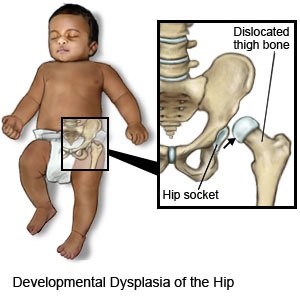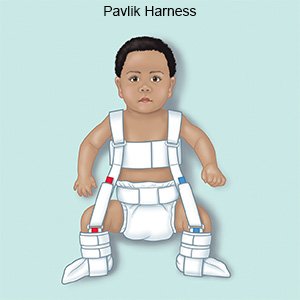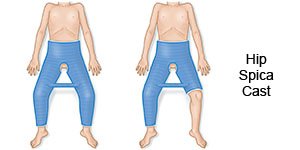Developmental Dysplasia of the Hip in Children
Medically reviewed by Drugs.com. Last updated on Aug 4, 2025.
AMBULATORY CARE:
Developmental dysplasia of the hip (DDH)
is a condition that prevents parts of your child's hip joints from fitting together correctly.
 |
Common symptoms include the following:
- Hips are not stable and pop in and out with movement
- Extra folds or wrinkles on the thigh
- One leg that is shorter than the other
- Pops and clicks heard or felt when your child moves his or her hips
- Problems crawling, walking, or moving
Call your local emergency number (911 in the US) if:
- Your child feels lightheaded, short of breath, and has chest pain.
Seek care immediately if:
- Your child's splint or cast gets damaged or breaks.
- Your child's skin around his or her toes or hips is blue, cold, or numb.
Call your child's doctor if:
- Your child's pain is getting worse, even after he or she has taken pain medicine.
- Your child's skin is itchy, swollen, or has a rash.
- You have questions or concerns about your child's condition or care.
Treatment for DDH
depends on your child's age and how bad the dysplasia is. The head of your child's femur may need to be put back into the hip socket.
- A splint called a Pavlik harness holds the hip in place for a few months. This harness makes the head of the femur fit correctly into the hip socket.

- A cast may be needed if your child is already walking when DDH is diagnosed. Healthcare providers may place your child in a cast that covers him or her from the chest down to the legs or knees. The cast will prevent your child's hips from moving and allow proper healing.

- Closed reduction is a procedure to realign a bone or bring the hip joint back to its normal position. This is done by moving the hips and femur without opening the skin.
- Surgery and a hip brace may also be used to fix and correct your child's hip problem.
- Traction pulls on the hip or thigh bones to pull them back into place. A pin may be put in your child's bone or cast, and hooked to ropes and a pulley. Weight is hung on the rope to help stretch the soft tissues around the hip bones. This helps the hip fit into the hip socket.
- Physical and occupational therapy may be needed. A physical therapist teaches your child exercises to help improve movement and strength. An occupational therapist teaches your child skills to help with daily activities.
Prevent blood clots:
Your child may be at risk for blood clots if he or she has limited movement. Ask your child's healthcare provider if your child needs to elevate his or her legs above the level of his or her heart. Elevation will keep blood from staying in his or her legs and may prevent blood clots from forming. As pain decreases, your child may need to start moving or walking to improve blood circulation and bone healing.
Manage your child's DDH:
- Your child needs rest to heal. Quiet play will keep your child safely busy. Have your child read or draw quietly when he or she is awake. Follow instructions for how much rest your child should get while he or she heals.
- Talk to your child's healthcare provider about exercise and play for your child. Together you can plan the best exercise program for your child. It is best to start slowly and do more as he or she gets stronger. Exercise will help make his or her bones and muscles stronger.
- Use a car seat and safety vest in the car. These are made for children in spica casts and Pavlik harnesses. They should be used while your child is in a car. Ask where you can get a car seat or safety vest for your child.
- Ask your child's healthcare provider how to use a hip brace correctly. To keep your child from falling, remove loose carpeting from the floor. Have him or her use chairs with side arms and hard cushions to make it easier to get out of a chair. You may want to put a chair or a commode inside the shower.
- Take your child to physical and occupational therapy as directed. A physical therapist teaches your child exercises to help him or her improve movement and strength. An occupational therapist teaches your child skills to help with his or her daily activities.
Follow up with your child's doctor as directed:
Write down your questions so you remember to ask them during your visits.
© Copyright Merative 2025 Information is for End User's use only and may not be sold, redistributed or otherwise used for commercial purposes.
The above information is an educational aid only. It is not intended as medical advice for individual conditions or treatments. Talk to your doctor, nurse or pharmacist before following any medical regimen to see if it is safe and effective for you.
Learn more about Developmental Dysplasia of the Hip
Care guides
Further information
Always consult your healthcare provider to ensure the information displayed on this page applies to your personal circumstances.
